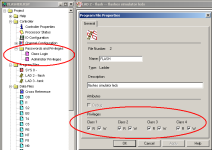Is it possible to make individual Ladders read only or password protected?
I'm not even sure I want this, but I'm trying to solve a problem.
Right now onsite electricians are able to edit our logic. I don't intend to take this away from them.
What I'm doing is having our inputs go to bits and our ouputs come from bits on one ladder. This way you don't have to make five edits to the program just to bypass one faulty plugged chute switch, and then lose track of half of them when the switch is fixed.
If I know some logic is correct, and it's rather complex, I'd like the power to lock it down until I'm consulted about changes.
I'm not even sure I want this, but I'm trying to solve a problem.
Right now onsite electricians are able to edit our logic. I don't intend to take this away from them.
What I'm doing is having our inputs go to bits and our ouputs come from bits on one ladder. This way you don't have to make five edits to the program just to bypass one faulty plugged chute switch, and then lose track of half of them when the switch is fixed.
If I know some logic is correct, and it's rather complex, I'd like the power to lock it down until I'm consulted about changes.




